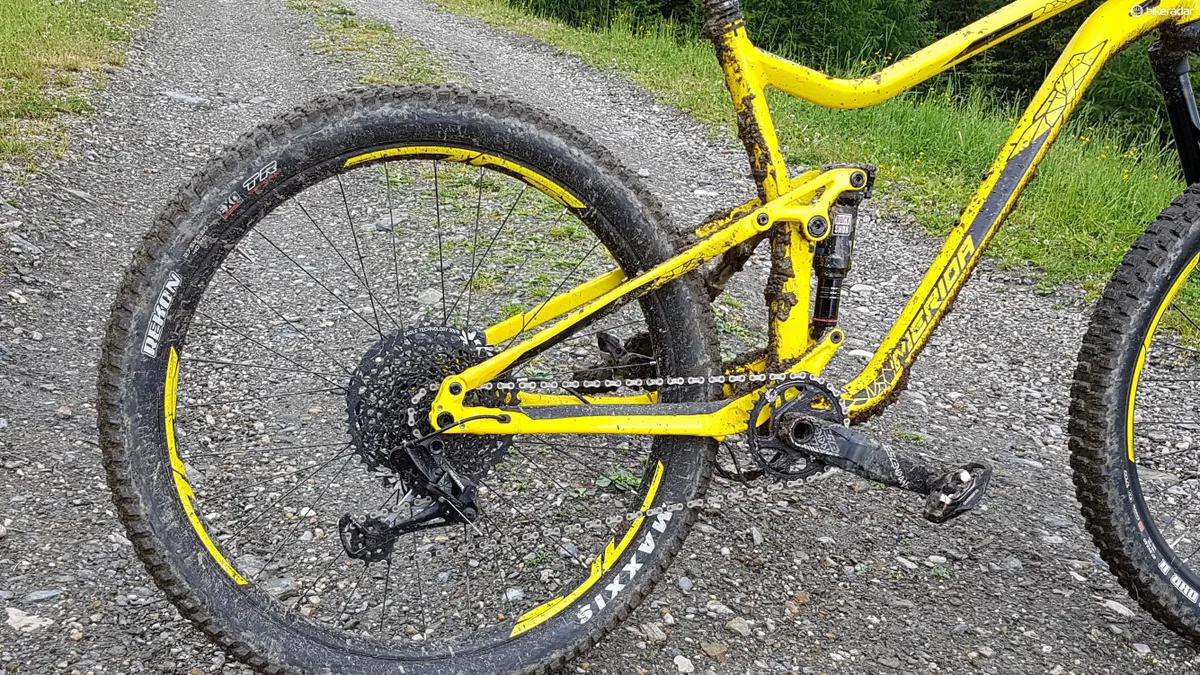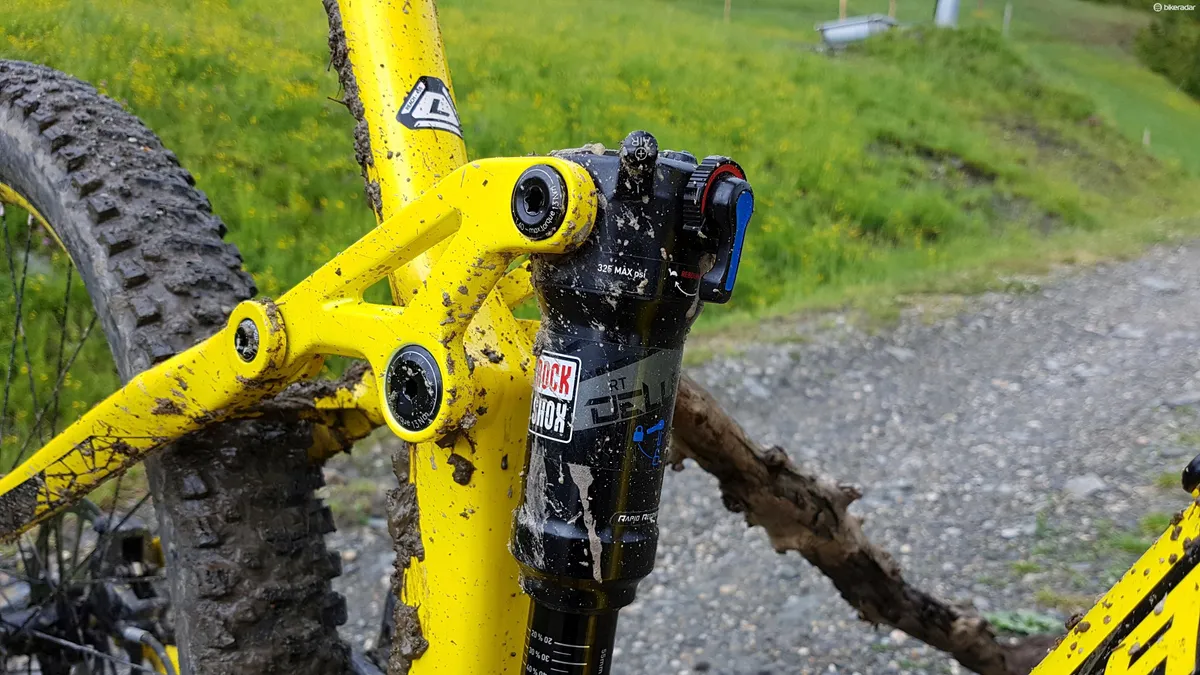Merida's One-Forty range is based around a new platform for 2018 – one that's drawn multiple plaudits as part of the longer-travel One-Sixty. In essence, it’s a linkage-driven single pivot bike, with 140mm of travel and a metric length, trunnion-mounted shock that floats between two pivots.
The floating pivot serves a couple of purposes – it allows Merida to have more control over the stroke behaviour of the shock, and gives it a feeling of ‘bottomless travel’ and increased small-bump sensitivity.
All members of the three-bike range are made from aluminium, for now, and they'll sit in a competitive price range (though UK and US prices are TBC).

Having ridden the One-Sixty the day before, at the Eurobike Media Days, we were keen to get onboard what should be a poppier, more lively version of the bike.
While the One-Sixty gets very contemporary geometry, the One-Forty is a touch more traditional. There’s ‘only’ a 454mm reach in size large, and this is paired with a 66.5-degree head angle. The figures are fine, but Merida make one well-shaped bike in the family, so why not extend this to the smaller-travel bike?
Merida One-Forty 7.800: spec as tested
Geometry aside, the top-level 7.800 model has some decent kit plugged into the frame.
RockShox takes care of the suspension, with the new Revelation fork matched to a Deluxe RT shock.

The Revelation has been updated for 2018, with the same chassis as the Pike, and the older Motion Control damper in there. This means there’s plenty of stiffness on offer from the Boost-width fork, and the damper is a well-regarded model.
The Deluxe RT shock has a larger volume than the Monarch that might have been fitted were Merida sticking to older-style shocks, and this, in theory, gives better heat management and sensitivity. There’s a lockout lever, should you need it, as well as rebound control.
SRAM’s GX Eagle is something we’re expecting to see on a lot of bikes in 2018 – it’s competitively priced, it’s performance (so far) seems great, and it opens out the ultra wide-range 10-50t 12-speed cassette to bikes far more affordable than the X01 and XX1 Eagle groupsets are ever likely to be attached to. It’s certainly no bad thing to find it here.

There’s also SRAM's Code R brakes, which again are updated for 2018. They have a larger-volume lever body and calliper, meaning more hydraulic fluid, which should help mitigate against heat buildup. They also benefit from the S4 calliper technology – a calliper/pad heat shield and more open calliper design – to again reduce heat build up.
As own-brand cockpit is joined by a KS Lev Integra seatpost.

Merida’s own wide-ish wheels, meanwhile, support a set of Maxxis 2.6in rubber. Up front there’s a triple-compound, EXO sidewall Minion DHF. At the back, a Rekon is present, also with the EXO sidewall, but a single compound construction.
Merida One-Forty 7.800: first ride impressions
Our test ride was on a set of bike park-type trails in Italy. This is perhaps not the One-Forty’s natural habitat, but was a decent enough place to get a few brief impressions of the bike.

The first thing I noticed was how cramped the bike felt when seated – the reach isn’t massive, and the stem is short (I’d not change this though). That said, when standing, the bike felt roomier – though still not exactly large.
I also spent a fair bit of time fiddling with the shock, ending up running it pretty fast (less rebound damping) in order to get the bike feeling lively. With the main pivot placement right behind the chainring, in a relatively neutral place, there’s minimal pedal kickback, but Merida seems to have specced a relatively heavily damped shock, perhaps to mitigate some of the ‘issues’ some people feel single-pivot bikes have.
Bear in mind we're talking box-fresh bikes though, so I’d like to see how they felt after more riding, when things have bedded in a bit.The result, though, was that the One-Forty felt a touch sluggish.

The floating shock design does handle chattery, small hits really well. This lets you get on with riding the bike, rather than fighting it through rough trails, but some riders may feel they want a bit more feedback from the rear wheel. The support offered from the shock is decent – in fast G-outs and bermed corners the back end stayed controlled, resisting blowing through its travel, while still dealing with mid-corner rocks and braking bumps.
Up front, the Revelation wasn’t quite the (ahem) revelation I was hoping for, though again, perhaps it’ll soften with time. I found it a little harsher than expected, though the stiffness is impressive.
There were no complaints about the tyres though. The Minion DHF in 2.6in form is grippy and, with a reasonably wide rim, well supported. On steeper, wet loam tracks I was more than happy pointing the front end down tight corners and over wet roots.
The Revelation does seem to have decent support too, so I never felt the front end diving towards a muddy oblivion.
At the back, the Rekon rolls well, and offers reasonable, if not amazing braking grip. The tyres and suspension work together well to provide good climbing traction. Arguably Maxxis’ WT (Wide Trail) tyres perform a touch better, and in 2.5in come up similarly voluminous, but weight and presumably cost will be a consideration for Merida.

If it sounds like I'm on a bit of a downer about the One-Forty, that’s not really the case. On initial impressions, this isn't a bike that’ll suit someone who wants a feedback-rich, playful ride, but more someone who wants a bike that’ll confidently descent a wide range of technical terrain, with no surprises. With a bit of bedding in, we suspect the suspension performance – both front and rear – will improve too.



